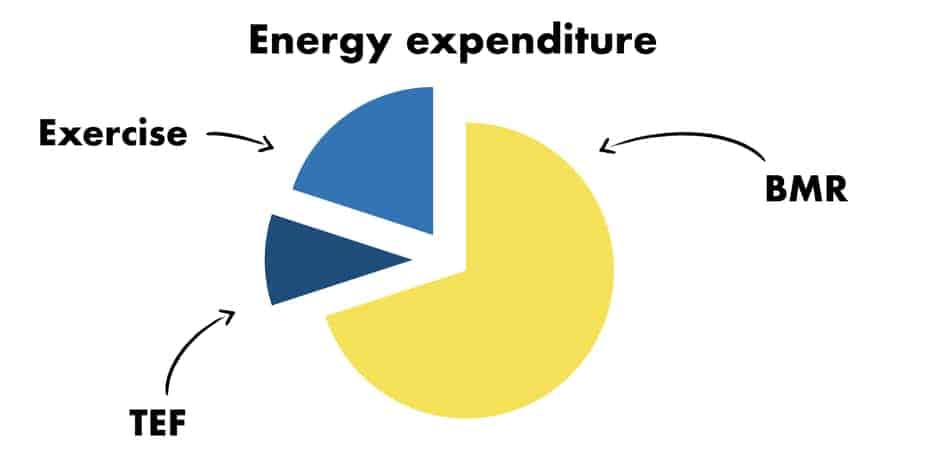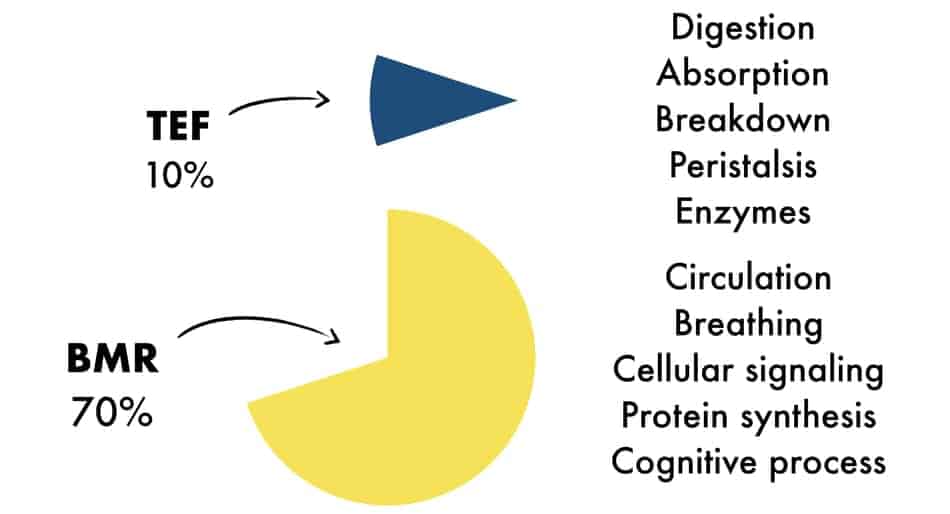One of the best things you can do while being in a calorie deficit is to lift weights. It can not only really speed up the process of getting lean but also maintain muscle mass.
Today I will explain what are the benefits of lifting weight while being in a calorie deficit, as well as give you some practical tips on how to do it.

As a whole, you can lift weights while being on a calorie deficit because lifting weights stimulate muscle protein synthesis and build muscle. The higher your lean body mass, the more calories you will burn throughout the day. However, you need to ensure you have enough dietary proteins becasue a negative energy balance increases the protein requirements.
In other words, it will help you stay lean and get even better results. However, your progress will be dependent on the type of workout you do, and the type of proteins you eat.
So here is my overall answer but if you wanna know more details like what happens to your body when you do weight training during a calorie deficit, keep reading.
What Happens If I Lift Weights On A Calorie Deficit?
When you lift weights on a calorie deficit your body will enhance muscle protein synthesis and stimulate hypertrophy, despite eating fewer calories. Lifting weights will promote muscle growth and help you improve your body composition without losing muscle mass.
To keep your muscle mass on while being in a calorie deficit, apart from lifting weights, you need to have enough proteins (source).
Protein will ensure your body has sufficient amino acids to maintain (and even build) muscle, burn more calories and keep you more energized.
Several studies confirm that a high-protein, hypocaloric diet, is enough to not only reduce body fat but improve lean body mass (muscle).
You can add more protein to your diet by supplementing with whey protein powder (this way you reduce the total amount of calories, but you still have your proteins).
One of my favorite protein powders is Optimum Nutrition Gold Standard (double chocolate flavor).

Lifting weights while cutting gives you more energy
Another benefit of lifting weights while cutting is energy.
When you’re on a calorie deficit, you may experience lower energy levels. So lifting weights can actually help you get more done, have better stamina, better libido, and better mental clarity, despite lower calories.
Lifting weights can lower your appetite during calorie restrictions
One thing that I noticed when doing calorie deficit for a long period of time, my appetite and hunger went through the roof. Two things that helped me reduce my appetite were, lifting weights and wearing a weighted vest all day.
Also lifting while being in a calorie deficit will lower your cravings for sweets.
This is a huge bonus because you won’t be nagged by those uncomfortable food cravings throughout the day. They still will be, but not as much after your workout.
Why Lift Weights In Calorie Deficit?
Another reason why you should lift weights during calorie deficit is it will increase your basal metabolic rate. Basal metabolic rate, physical activity (exercise), thermic effect of food, and non-exercise activity thermogenesis all are the ways that count towards calorie deficit.
In the graph below you can see the proportions of how many calories your body uses during the day.

As you can see, basal metabolic rate is by far the most “metabolically expensive”.
BMR requires a lot of energy for all the vital body processes (you don’t have to even move your finger).
Another two parts are exercise and TEF (thermic effect of food).
Lifting weights during calorie deficit increases your physical activity
Physical activity is an additional movement you do that increases your heart rate and oxygen demand. Transport of oxygen throughout the body is expensive.
So the more you move, the more you force your heart to pump the blood and oxygenate your muscles, the more energy you burn.
The thermic effect of food is the process of how your body breakdown, digests and absorbs all the nutrients from food.
For example, when you eat your meal, the body needs to perform several chemical and mechanical processes that will extract energy from the food you just had.
Non-exercise activity thermogenesis is everything else you do during the day that is not counted as exercise, but you still moving. Typing on the keyboard, walking, squatting from the chair, movings objects from one place to another, etc.
See below.

Your body uses energy for BMR (basal metabolic rate), NEAT (non-exercise activity thermogenesis), and TEF (thermic effect of food). Those processes can add up to over 70-90% of the total energy expenditure, depending on your activity level.
This means your body is burning plenty of calories without you stepping your foot on the treadmill or elliptical (source). It takes so much energy for all the vital functions like breathing, digestion, circulation, cognitive function, and more.
So creating a calorie deficit can be easily achieved by reducing the calories consumed, without even doing exercise. However, doing regular resistance training can help with keeping the BMR even higher. Because BMR is strictly dependent on the amount of your muscle mass.
It takes tons more calories to push the oxygenated blood through the muscle mass. So the more muscle mass you have, the more calories will be used.
How To Do Weight Training While Calorie Deficit?
- Use full body workout – The easiest way to do weight training while being in a calorie deficit is by doing a full-body workout 3 times per week.
- Use compound movements – On each training day, you start with compound exercises (squats, bench press, pull-ups, overhead press, deadlifts) for 3-4 sets each.
Doing compound exercises first save your energy for the most important lifts. And by doing all body in one workout you not only attack more muscle (burn more calories) but you also make sure you’re not leaving behind any muscle group.
- Sprinkle some isolation work – After doing the heavy lifting, you can add some additional isolation exercises to attack specific muscles like biceps, triceps, abs, or glutes. Depending on your goals, you can spend extra time doing those isolation work. But that has to be done after the big lifts.
- Apply progressive overload – Progressive overload means doing more training volume over time. That can be done via more reps, sets, workouts per week, or load.
Why should I lift weights in a calorie deficit? Overall, you should lift weights in a calorie deficit because it will improve your body composition by preserving muscle mass and keeping your metabolic rate high. Resting metabolic rate is the number of calories you burn at rest. The more weights you lift, the more muscle mass you have.
Check out my article where I explain how to build glutes on a calorie deficit
Related article: Can You Build Glutes In A Calorie Deficit?
Calorie Deficit Without Lifting Weights
One of the biggest mistakes people make during calorie restriction is they focus only on counting calories, but forget about doing weight training. Over time, this can lead to muscle loss as well as affect jo-jo where people gain the weight back up.
Let me explain
During the times of calorie maintenance, which is when you eat at the level that you maintain your body weight, the body has a set requirement of proteins (around 1.2 grams of protein per kilogram).
However.
During calorie restrictions, the muscle protein breakdown increases, and protein requirements go up significantly (I won’t cover here the mechanics of this process. I’ve already covered that in my article “calorie deficit and protein“, which I recommend your read.
Frequently Asked Questions
Can you put on weight in a calorie deficit?
You can put on lean body weight while you’re in calorie deficit only when you’re doing resistance training with the addition of an adequate amount of daily proteins. You to stimulate muscle protein synthesis you need 1 gram of protein per pound of body weight.
In other words, you need to eat a lot of proteins every day and lift weights to really put on weight. And while being in a calorie deficit, this means that almost all of your calories need to come from proteins (source).
This is what many bodybuilders do to maintain a lean physique all year round. A lot of fitness models got their commission from shooting pictures.
And if someone is ripped all year round this means they will get hired more often, comparing to someone who is only lean before the competition.
So to stay extra lean they must stay in a caloric deficit (or very close to it) and consume plenty of proteins round the clock.
So people do it. But it can get boring very quickly. That’s why this approach is doable, but not sustainable for everyone.
Conclusion
You can lift weights on a calorie deficit to not only have better results, but also to make the whole process much more sustainable.
The more you stay active, the less appetite you will get. So it will help you not only stay physically strong but also mentally strong, without draining your iron willpower.

Hi there I was just wondering , I was 110 kg I have been in a calorie deficit and strength training for nearly 3 months , I managed to loose 3kg but don’t seem to be loosing as much as I thought I would be am on about 2000cals , I eat loads of protein and creatine , am I building muscle but loosing fat and it’s keeping the scales the same?
muscle weighs more then fat so that is most likely what is happening to you.